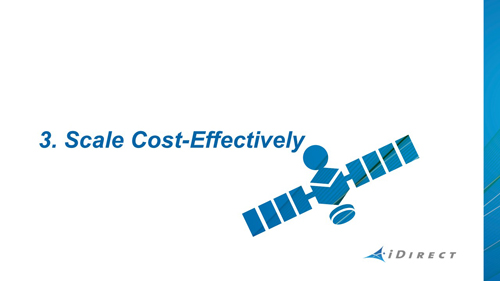
This is part three of a five-part series about harnessing HTS and DVB-S2X to its fullest potential and being ready for the future of our industry. Read Part I – Enabling Higher Capacity Efficiencies and Part II – Implementing Intelligent Terminals.
When it comes to scaling a satellite communications network, hub-side infrastructure is one of the largest capital expenses service providers face. In fact, the infrastructure decision can make or break the ability to profitably expand, enter new markets and introduce new services.
With HTS and DVB-S2X, this reality has reached a new level of importance. With greater demand for higher throughputs and more satellite bandwidth comes the need to deploy and manage large-scale networks. Network operators need to change the cost model for ground infrastructure deployment, keeping up with demand without dramatically increasing capital and operating expenses.
Today, there are key advances in gateway technology. Consider hub solutions leveraging virtualization for processing capabilities that significantly increase the teleport’s capabilities to support extensive networks and higher throughputs in the same space. When you can achieve greatly improved density, it results in a massive footprint reduction, decreasing cooling and IT management expenses. Operating large networks spanning multiple spot beams versus one wide beam can make scaling more challenging for service providers, especially when expanding into new service areas.
With the right bandwidth management capabilities, satellite operators can manage Mbps across multiple spot beams and create a virtual bandwidth pool for service providers to use. This will allow service providers to not have to operate many spot beams but instead use the advantages of virtual network operations and still be in control of their own SLAs and service offerings to their end customers.
iDirect’s hub chassis has a modular design ideal for scalability. It’s designed to be populated with network line cards that can be upgraded with licensable features, and enables HTS operators to increase throughput rates based on network demands.
With this bandwidth management capabilities optimized for HTS multi-spot beam operation, satellite operators now have the flexibility to sell wholesale capacity, offer managed Mbps services or offer vertically integrated solutions that encompass the entire value chain. As for service providers, they now have the ability to choose from different business models while managing a blended capacity and managed services portfolio all on one platform.
How satellite operators and service providers leverage HTS and DVB-S2X technology will largely determine how they capitalize on growth opportunities. Thanks to recent advances in gateway technology, operators can manage bandwidth and maintain a high level of flexibility.
Explore all five critical requirements for harnessing HTS and DVB-S2X.
Don’t forget to take our poll:
